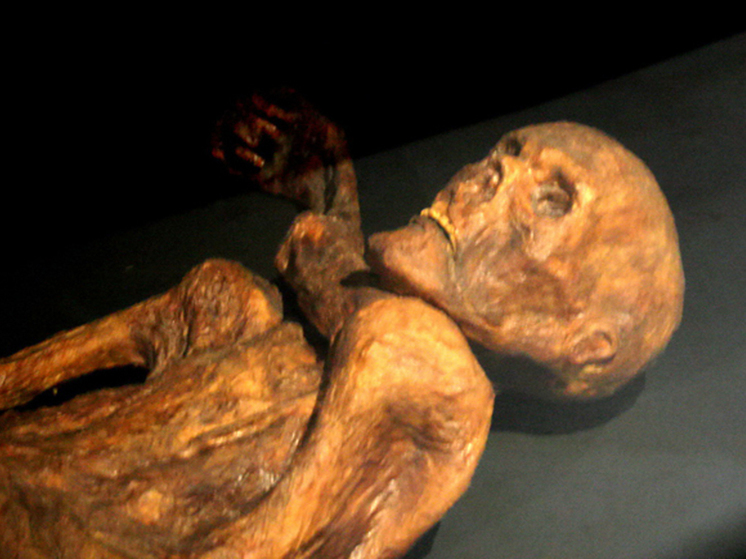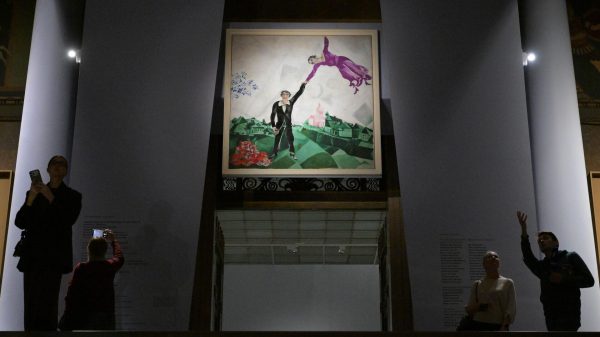Prehistoric body art has aroused the wild interest of researchers
More than sixty tattoos of the famous Ötzi — the Ice Man were made differently from what archaeologists first thought. The remains of Ötzi the Iceman are exhibited in the refrigeration chamber of the Archaeological Museum of South Tyrol in Bolzano (Italy).

Found high in the Tyrolean Alps in 1991, Ötzi the Iceman had dark skin and dark eyes and was likely bald. His remarkably well-preserved remains, which had lain under ice for some 5,300 years, revealed 61 inked tattoos all over his body.
How and why Ötzi, perhaps the world's most studied corpse, received body art has long been a source of fascination, CNN reports. Initial analysis revealed that the tattoos were applied with a blade and then infused with black pigment. Recent research strongly suggests that the markings may have concealed a single-point piercing instrument coated with charcoal pigment.
“One of the reasons we found is that most of the work that was done on his tattoos was originally done by scientists who were excellent scientists but did not tattoo themselves and had no personal experience with the tattooing process.” , says Aaron Deter-Wolff, lead author of the new study.
“Over the years, I've talked to professional tattoo artists many times, and when you start talking about it and look at the photos, they say, 'Oh, no, oh no, they absolutely don't cut into the skin… but that hasn't been shown in a scientifically valid setting,» he explained. Deter-Wolff, a prehistoric archaeologist with the Tennessee Department of Archeology, who has a tattoo similar to the tattoo on his wrist Ötzi, CNN notes.
The study, published in the European Journal of Archeology in mid-March, reviewed the existing literature on Ötzi tattoos and used modern experiments that replicate ancient tattooing techniques.
“Most of them were on the shins and ankles. One on the left wrist, and several more on the lower back around the cervical spine, Deter-Wolf said. – In some cases these are lines that intersect, but more often they are parallel to each other. Their number varies from two lines to five or six.”
Scientists have analyzed almost every detail of Ötzi's body and belongings, painting an intimate picture of life at the end of the fourth millennium BC. And now new research is providing a better understanding of how the oldest known tattoos in human history were created, although questions still remain about the meaning of body art.
Researchers initially believed Ötzi had frozen to death, but an X-ray taken in 2001 revealed a potentially fatal arrowhead in his shoulder. The Iceman also had a head injury, possibly sustained at the same time, and a self-defense wound on his right arm.
The mystery of Ötzi's violent death, who he was and how he ended up on the mountain pass, has caused interest goes far beyond archaeology. Every year, thousands of people visit his mummified remains, which are on display at the Archaeological Museum of South Tyrol in Bolzano (Italy).
The existing scientific base on Ötzi is amazingly extensive. The contents of his stomach revealed his last meal and where he came from, research into his DNA revealed his origins and appearance, his weapons revealed that he was right-handed, and his clothing gave a rare glimpse into how the ancients actually wore people.
In a February 2016 study, Deter-Wolf compiled a database of dozens of examples of ancient tattoos, including body art found on the mummified remains of the Egyptians, Chinese and Incas, which identified Ötzi's body art as the oldest known example of tattooing. . This feat was made possible thanks to non-destructive digital imaging technology and the collaboration of archaeologists and tattoo artists.
A 2016 study shows that tattooing is a long-standing and widespread cultural practice, using various methods to permanently inject pigments under the skin, CNN highlights. These methods include poking or tapping with the hand using a single-point instrument that may or may not have a handle; incision; and applying subcutaneous tattooing or stitching the skin using a needle through which ink-soaked thread or tendon is threaded.
Deter-Wolf and his colleagues also experimented with various traditional techniques in a September 2022 study. Using eight tools made from animal bone, obsidian, copper and boar tusk, as well as a modern steel needle, New Zealand traditional tattoo artist and study co-author Danny Riday tattooed his leg.
According to Deter-Wolff, the tattoos on Ötzi's body have rounded edges, consistent with a hand-applied tattoo, most likely with bone or copper. In contrast, a cut tattoo creates sharp edges due to the lines cutting into the skin.
“There are differences in the line because you're making all these individual punctures so close to each other, and how much they overlap creates a sort of pinpoint effect when you look at it at high enough magnification.”
A bone awl that Ötzi carried in his tool kit was a potential candidate, but it has yet to be studied in detail to confirm whether the microscopic wear marks correspond to the function of a tattoo. However, Deter-Wolf says this is unlikely: “It's more like a gamekeeper's kit than a tattoo kit.”
According to Dr Matt Lodder, senior lecturer in art history and theory and director of American Studies at the University of Essex in UK, the new knowledge of how Ötzi's tattoos were likely made was «particularly exciting» as the piercing method used showed continuity with modern tattooing techniques.
“The real magic of Ötzi's story for a modern person is how familiar it seems — anyone who has had a tattoo, especially if you did it with hand tools, can imagine the feeling they would feel while getting a tattoo, the process they went through went through to heal my tattoos,” says Lodder, who is also the author of Painted People: Humanity in 21 Tattoos. He did not participate in the study.
“That we can empathize so strongly with a man who lived five thousand years ago is an amazingly powerful connection to our shared human past.”
Why did Ötzi have so many tattoos? One explanation given in the scientific literature is that it was an ancient healing technique, a bit like an early form of acupuncture, rather than body art. Many of the tattoos may have been an ancient way to treat joint pain in the lower back, knees, hips and wrists.
“We don't object to the idea that they could be therapeutic. I think all this is being discussed. The fact that something has a therapeutic effect on us does not mean that it does not have cultural and symbolic value,” emphasizes Deter-Wolf.
Marco Samadelli, Senior Researcher at the Mummy Institute of Eurac Research, private research institute in Bolzano, claims that the work was carried out at a “high scientific level.”
“The authors do not state with absolute certainty the technique of tattooing by piercing with a pointed instrument, but give detailed and plausible explanations,» he states.
Samadelly encouraged the team to continue studying Ötzi's tattoos and how they were made: «There are currently no plans to examine the bone awl and horn tooth found on the Iceman to find out whether they were used as hand tools, but I hope that Aaron Deter-Wolf will maintain his interest and contact the scientific committee of the Ötzi Museum for their analysis and study.”




















































Свежие комментарии